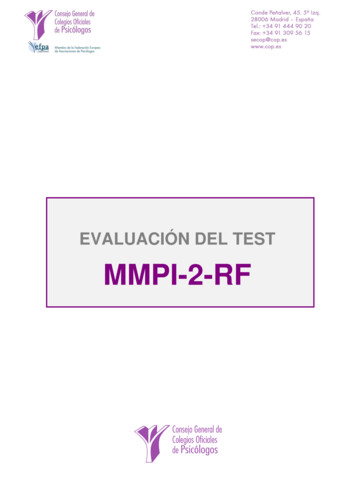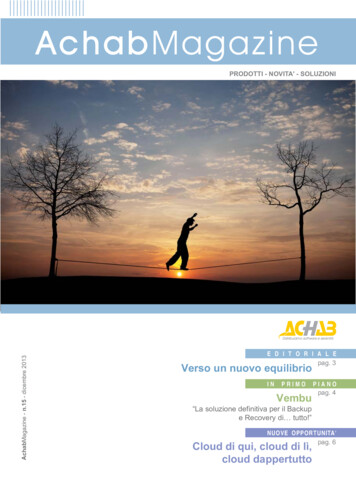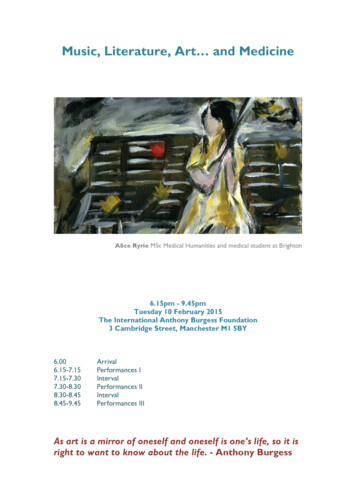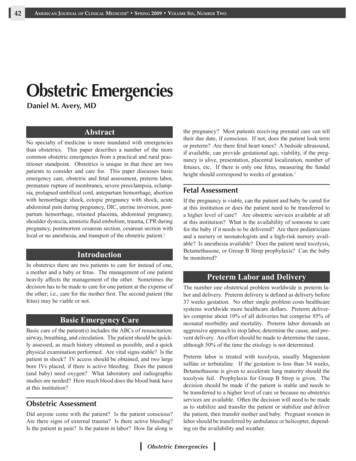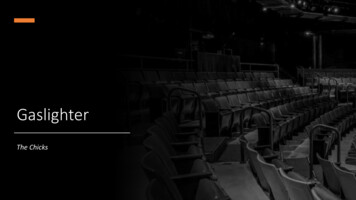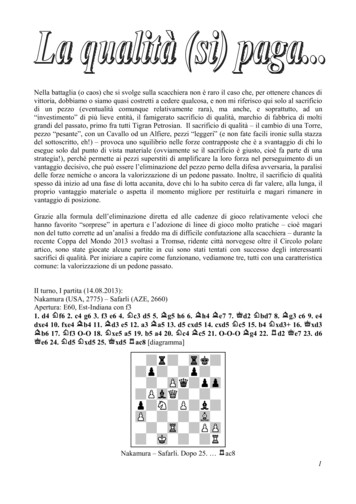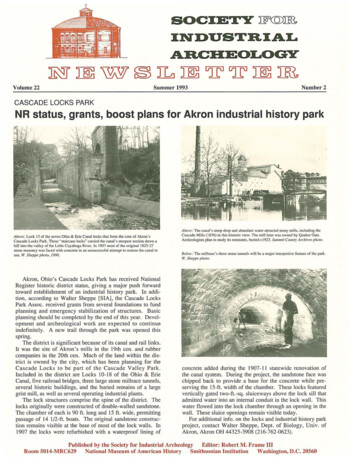
Transcription
tSOCJ:E*I'Y W@IE&J:N':O"'USTR,J:A.LA.R,C:H:EOLOGY W!Yl JL mVolume 22Summer 1993Number 2CASCADE LOCKS PARKNR status, grants, boost plans for Akron industrial history parkAbove: The canal's steep drop and abundant water att racted many mills, including th eAbove: Lock 13 of the seven Ohio & Erie Canal locks that form the core of Akron' sCascade Locks Park. These "staircase locks" carried the canal ' s steepest section down ahill into the valley of the Little Cuyahoga River. In 1907 most of the original 1825-27stone masonry was faced with concrete in an unsuccessful attempt to restore the canal touse. W. Sheppe photo, 1990.Akron, Ohio's Cascade Locks Park has received NationalRegister historic district status, giving a major push forwardtoward establishment of an industrial history park. In addition, according to Walter Sheppe [SIA], the Cascade LocksPark Assoc. received grants from several foundations to fundplanning and emergency stabilization of structures. Basicplanning should be completed by the end of this year. Development and archeological work are expected to continueindefinitely. A new trail through the park was opened thisspring.The district is significant because of its canal and rail links.It was the site of Akron's mills in the 19th cen. and rubbercompanies in the 20th cen. Much of the land within the district is owned by the city, which has been planning for theCascade Locks to be part of the Cascade Valley Park.Included in the district are Locks 10-18 of the Ohio & ErieCanal, five railroad bridges, three large stone millrace tunnels ,several historic buildings, and the buried remains of a largegrist mill, as well as several operating industrial plants.The lock structures comprise the spine of the district. Thelocks originally were constructed of double-walled sandstone.The chamber of each is 90 ft. long and 15 ft. wide, permittingpassage of 14 1/2-ft. boats. The original sandstone construction remains visible at the base of most of the lock walls. In1907 the locks were refurbished with a waterproof lining ofCascade Mills (I 876) in this historic view. The mill later was owned by Quaker Oats.Archeolog ists plan to study its remnants, buried c 1923. Summit County Archives photo.Below: The millrace's three stone tunnels will be a major interpretive feature of the park.W. Sheppe photo.concrete added during the 1907-11 statewide renovation ofthe canal system. During the project, the sandstone face waschipped back to provide a base for the concrete while preserving the 15-ft. width of the chamber. These locks featuredvertically gated two-ft.-sq. sluiceways above the lock sill thatadmitted water into an internal conduit in the lock wall. Thiswater flowed into the lock chamber through an opening in thewall. These sluice openings remain visible today.For additional info. on the locks and industrial history parkproject, contact Walter Sheppe, Dept. of Biology, Univ. ofAkron, Akron OH 44325-3908 (216-762-0623).Published by the Society for Industrial ArcheologyEditor: Robert M. Frame IIIRoom 5014-MRC629National Museum of American HistorySmithsonian InstitutionWashington, D.C. 20560
BR IDGE NEWSTRUSS SAVED, REUSED IN EVERETT. Richard Eitel isa marine contractor in Everett, Wash. According to a Mar. 15 ,1993 story in Engineering News Record, for ten years Eitelhad been storing a 144-ft. Warren truss span that he removedfrom a single-leaf bascule bridge elsewhere in SnohomishCounty. Originally erected in the 1920s, Eitel warehoused hisbridge intact, without disassembling it. Now, in 1993, he wasoffering it to the county for use at a new site, saving some 300,000 over new construction. Eitel will tow his truss on abarge, mounted on timber cribbage, much as he removed thetruss originally (and visible in an ENR photograph).1876 STONE AQUEDUCT RESTORED IN MASS. TheBoston Water Works constructed Echo Bridge in UpperNewton Falls, Mass., in 1878, to carry water from the Sudbury River to the Chestnut Hill Reservoir. At the time, thecentral 130-ft. span was the second longest stone-arch span inthe U.S. after the Cabin John Aqueduct in Montgomery Co.,Md., according to Donald C. Jackson [SIA] in Great American Bridges & Dams. The current owner, Mass. WaterResources Authority (MWRA), began a restoration programin 1990, contracting with the Society for the Preservation ofNew England Antiquities as a preservation consultant. Theproject is outlined in a recent issue of the SPNEA newsletter,with photographs. In the restoration process, a special sandblasting process was employed with the concurrence of theMass. Historical Commission. A special fine sand, applied at75 psi, removed stains and did not damage the granite surface.The spent sand was collected and disposed elsewhere.FRENCH KING BRIDGE REDEDICATED. The FrenchKing Bridge over the Connecticut River, on Route 2 nearGreenfield, Mass. was rededicated last Sept., following amajor 5.2-million renovation. The 783-ft. structure is a highsteel-arch deck truss. Built as a Depression-era federal reliefproject, it earned the Award of Merit from the American Institute of Steel Construction as the " Most Beautiful Bridge Builtin 1932." It was designed by the Dept. of Public Works. Itsname comes from the legend of French King Rock, which sitsin the middle of the river north of the bridge in a gorge bordered by 100-ft. high riverbanks. The scene looking uprivertoward the rock is one of the most photographed spots inFranklin County. Today only the top of the rock is visible,but in the mid-19th-cen., prior to construction of a dam atTurners Falls, the rock rose 16 ft. above the water. The newlyrestored bridge was dedicated as a memorial to former Congressman Silvio 0 . Conte, who secured much of the renovation monies. During the ceremony, films of the 1932dedication were screened.B.D.Lichtenstein & Assoc. restores big Chattanooga truss in 4.5-million projectThe 102-year-old Walnut Street Bridge in Chattanooga,Tenn. , oldest surviving major truss bridge in the South, wasrefurbished this spring in a 4.5-million project by A.G .Lichtenstein & Assoc., Fair Lawn, N.J. The six-span, pinconnected camelback Pratt truss is the oldest surviving bridgeacross the 1,500-mi. Tennessee River. It was designed byconsulting engineer Edwin Thacher of Lousiville, Ky., andcompleted in 1891. Despite numerous attempts at rehabilitation over the years, the bridge was closed in 1978.In the 1980s community sentiment supported refurbishingthe structure as a pedestrian bridge in a linear park. A 4.5million reconstruction project was begun in 1991, using a posttensioning system developed by A.G. Lichtenstein & Assoc. ,project engineers. It employs straight and deflected strandsplaced to coincide with the bottom chords and the diagonalsfanning away from the mid-span. The strands were deflected atcertain lower joints by wrapping them over specially constructed saddles attached to the lower joint pins. The work wascompleted this spring and celebrated in a great rededicationceremony on May I. It will be used for festivals, exhibits, anda future riverfront trolley system.J.J.P.restoration on May I,1993.Photos courtesy J J .Pul/aro.2SIA Newsletter, Vol. 22, No. 2, Summer 1993
Sen. John Danforth leads rededication of significant Missouri trussIn April, Sen. John Danforth joined county and municipaldignitaries in Kimmswick, Mo. to rededicate the newly refurbished Windsor Harbor Bridge as a pedestrian bridge and recognize its inclusion in the National Register. Danforthcelebrated the community effort as "a mission of the peoplewho live here, who wanted to keep the bridge, and whowanted it to not be torn down, and who wanted it to be designated as a historic site."The bridge was constructed in Carondelet-now a part ofsouth St. Louis-in 1874 by the Keystone Bridge Co. of Pittsburgh. It stood in Lemay until 1928, when it was scheduledfor demolition and replacement. Jefferson County purchasedthe bridge and moved it in 1930. It served as a vehicularbridge in Kimmswick until 1977, when it was again slated fordemolition. Area residents joined together to support preservation of the venerable structure and argue for construction ofa new bridge alongside the existing one.The county was persuaded and placed the Windsor HarborBridge in the care of the Kimmswick Historical Society. The1993 dedication marked the completion of a ten-year effort toCommunity effort saveshistoric came/back in N. C.Missouri Sen. John Danforth rededicates the refurbished 1874 truss on April 12. Notethe Keystone Bridge Co. 's signature: endpost columns patented by Jacob H. Linville.Patrick Martin photorestore the bridge with a new wooden deck, refurbished ironwork, and replication of the original builder's plate.B.E.The preserved bridge is a single, 106-ft., eight-panel, pinconnected, camelback through-truss. It was relocated to itspresent site in 1908 to replace a covered bridge destroyed in afreshet. The camelback was moved 30 miles from Cape Fearriver in Lillington and is reported to be over 100 years old.The Deep River Park Assn. was primarily responsible forsaving the bridge, which will form part of the group's recreational trail for walking, cycling, and horseback riding.Before being transferred to the Assn. it was repaired andpainted by the N.C. Dept. of Trans.WJ.E.WHAT TRUSS IS THIS? You won't find this configurationon the classic yellow truss wallchart. The thin truss spans asmall stream adjacent to the Thingborg textile center, near theroad from Selfoss to Skalhold, in south Iceland. When thelocal farmers needed a bridge, they simply used the remainsThe newly restored camelback truss, located near Sanford, N.C. TI1e gateposts of locallyquarried sandstone and locally manufactured brick have recesses for sculpture by an areaartist. Ms. Baldrick photo courtesy ofW.J. Ellenberger.Historic Cumnock Bridge near Sanford, N.C., was savedfrom destruction and preserved for recreational use when itsreplacement, a multi-lane reinforced-concrete highway bridgewas constructed nearby on a new alignment. The two bridgesspan Deep River where it forms the boundary between Leeand Chatham counties.Last Oct. 3rd was a day of celebration, with representatives of historical associations, service clubs, and the business community joining with the commissioners of the twocounties at a parade, speeches, and ribbon cutting ceremonies. An additional ceremony was held to unveil aNational Register plaque.SIA Newsleuer, Vol. 22, No. 2, Summer 1993of an old dragline crane for both the span and the piers.Thanks to Ned Heite [SIA] for the photograph of this unusualbridge. Compare this with other bizarre bridge examples,including the Great Northern RR car "covered bridge" inMinnesota [SJAN Spring 84:8] and the "twig & timber" fantasy in a roadside park near Gaylord in Otsego County,Michigan [SIAN 1985(2): 14].3
Turning the world over at HagleyTurners and turning historians from distant latitudes andlongitudes arrived at the Hagley Museum & Library inDelaware for the "World Turning Conference" held thereApril 21-24. They brought with them their turnings, tools,and lathes, as well as slide illustrations for talks and demonstrations of ancient and new lathe techniques. British polelathe turners traded tips with creators of an Americancomputer-driven ornamental lathe, while art-turners and educators from New Zealand, Australia, Germany, Scandinavia,Japan, and North America pondered the worldwide craft ofturning as mental exercise, therapy, and art.Tree physiology, forest conservation, Jacobean miniatureframes, Nordic drinking cups, metal spinning, oval turning,sculpture-copying, chair and spinning-wheel construction, andfoundry pattern-making, among many other lathe-orientedtopics, received exposition, scrutiny, and discussion by infectiously enthusiastic conferees. Two participants even sportedturned wooden hats! Of special interest were presentations bynewly mobile East Germans about the turned-toy industry ofthe Erzgebirge, and the technique of turning rings whosecross-sections have the outline of toy animals.Concurrently, the co-sponsores of the conference, HagleyMuseum & Library and the Wood-Turning Center in Phila.,opened "Art From the Lathe," a stunning exhibit of international lathe-turned objects and historic turning lathes. It willstay open to the public at the Hagley Museum through Nov.1993.Albert LeCoff, director of the Wood-Turning Center, ablyassisted by Tina LeCoff [SIA] and Charles Hummel, Winterthur Museum emeritus, as well as the staff of Hagley, conceived, organized, and presided over the multi-faceted eventsof the conference with amazing tranquility and good cheer.The conference proceedings will be published in 1994 asInternational lathe-Turning: New Perspectives (pre-order for 30 ppd. from Wood Turning Center, POB 25706, Phila. PA19144). Nifty cotton tee shirts displaying Besson's 16th-cen.eliptical turner may still be available for 13 ppd (phone 215844-2188, fax 844-6116).C.C.C.4Left: Using seasoned wood, Jon Siegel of West Franklin, N.H., shows how to tum anoff-center blank to make Dutch- or spoon-foot table legs on a modem powered lathe.Center: Jaques [sic) Besson's late-16th-cen. elliptical turning lathe graced the conf.poster and also turned up in a paper by Carolyn Cooper [SIA].Right: "Bodger" Stuart King from the Chiltern woods of Buckinghamshire, England,demonstrates the use of a springy pole-lathe (updated with overhead bungee cord) to tumWindsor chair legs from local green wood. C. Cooper photos.SITESBMI CRANE HONORED. The Baltimore Museum ofIndustry's newly restored 1942 Clyde whirly shipyard craneinstalled at the Museum's entrance received one of eight 1993Preservation Awards from Baltimore Heritage, Inc. In 1991BMI's 1906 steam tugboat S.S. Baltimore won the sameaward. Both the crane and tugboat are considered excellentexamples of the use of volunteer efforts and in-kind donationsin the field of preservation. The 60-ft.-tall crane was one ofthree that dominated the skyline over Key Hwy. at the Bethlehem Steel (repair) shipyard. When the property was purchased for development of Harborview marina andcondominiums, the cranes were removed and one wasdonated to BMI. Restoration and reinstallation at BMI took ayear and over 300,000 of contributed labor and materialsfrom two dozen Baltimore companies. Info.: BMI, 1415 KeyHwy., Bait. MD 21230 (410-727-4808).The restored 1942Clyde whirlyshipyard crane nowinstalled at theentrance to theBaltimore Museumof Industry.E.H. Remsbergphoto , courtesy ofBaltimore Museumof !11d11stry.
A SEARCH FOR ORIGINSRetracing an original ore journey from the Mesabi to BuffaloIn mounting its new exhibition on local industry, theBuffalo & Erie County Historical Society required specimensof natural iron ore as well as the pellets now commonly usedas blast-furnace feed. Tom Leary and Libby Sholes [bothSIA], consultants on the BECHS project, agreed to unearthsuitable ore samples and arrange for their transportation backto Buffalo.During the summer of 1992 they were quite surprised todiscover that an era of iron-mining history had actually terminated. Coincident with the centennial of the first shipmentfrom the Mesabi Range, the last natural ore mine in NorthAmerica had ceased operations. Leary and Sholes staked aclaim to a very small portion of the existing stockpile andlater proceeded to Minnesota's Iron Range to collect theprize.Their destination was the McKinley Extension Mine ofLTV Steel's Northwest Ore Div., located on the easternMesabi in the vicinity of Aurora and Hoyt Lakes. Here,crude ore from the Donora and Stevens pits was upgradedthrough screening, crushing, and washing processes at a beneficiation facility transplanted from McKinley, Minn. TheStevens mine discontinued production in 1990. Ore reservesat the Donora property were exhausted the following year.The processing plant, the last active iron-ore washing operation in either the U.S. or Canada, continued to work fromstockpiled ore until July 22, 1992. Through the autumn,McKinley Extension shipped sinter feed product throughTaconite Harbor for delivery to lower lakes ports.Sholes and Leary arrived in Duluth just in time to witnessone of the "Gales of November" that often have disrupted lateseason shipping on the Great Lakes. This particular blow sentboth vessels and visitors from Buffalo scurrying for shelteredanchorages and harbors of refuge. Several days later, theiron-ore expedition finally made its way up to the Range,through Gilbert and picturesque Biwabik, to the LTV site,which is still surrounded by active taconite mines.Though much of the natural ore product had been shippedout earlier, LTV personnel had thoughtfully set aside about150 lbs.- a thimbleful by Mesabi standards-for the BECHSexhibit. These specimens were bagged, boxed, and deliveredto Buffalo by a novel mode of iron-ore transport: a 1989Chevy Cavalier wagon and Roadway Express, Inc., whoseDuluth freight terminal is located in the shadow of the historicMissabe RR ore docks. In keeping with Iron Range traditions, that the last car loaded out from a mine also shouldcarry the symbol of a "clean sweep," one of the boxes boundfor Buffalo contained a small whisk broom.The shipment consisted of two varieties of processed natural iron: coarse ore, sized 1 x 4-ins., and minus-3/8-in. beneficiated concentrate. The coarse (I ump) ores were usedprimarily for slag control in electric furnaces. This producthad a dry analysi s of 58% iron and 7.75% silica. Relativelysmall tonnages of coarse ore shipments to North Americancustomers often used all-rail routes . Beneficiated minus-3/8in. fines were blended with minus-1/2-in. crushed ore fromanother mine to make up sinter feed that was loaded out atTaconite Harbor for LTV Steel's Indiana Harbor Works. Theproduct grading of the sinter fines averaged 58.8% iron andSIA Newsle11er, Vol. 22, No. 2, Summer 1993Above: LTV Siccl 's McKinley Extension Mine, silc of !he las! active natural iron-oreprocessing facility in North America. Located on !he Mesabi Range, near Aurora andHoyt Lakes, Minn.Below: Iron-ore shipping, impromptu vs. 1ried-&-true, in Duluth. In the foreground arcmolar vehicles preparing 10 carry Mesabi ore specimens from Duluth to Buffalo; in thebackground, cars on the 1res1Ies lead ing to the Dululh, Missabe & Iron Range Rwy. oredocks. Leary & Sholes photos.7.9% silica. At the sintering plant the blended natural ore wasfurther mixed with taconite pellet chips. Some blast-furnacemanagers included natural ore sinter in their recipes ratherthan relying on 100% pelletized feed, since the blendingseemed to prolong the life of refractory linings.BECHS was fortunate to have secured significant samplesof natural ore products at the close of an epoch in NorthAmerican iron-ore mining. For their invaluable assistance,particular thanks are due to C. Patrick Labadie of the CanalPark Marine Museum in Duluth; Don Wright of Westmoreland, Larsen & Webster, also in Duluth; and LTV ' s Donald B.Lemay and Eugene G. Garner. Some of the ore is now on display as part of "BFLO. MADE!," a 3500-sq.-ft. permanentexhibit in the Pan-American Building, the venue for theopening reception at the 1992 SIA Annual Conf. A video onthe last year of mining operations at McKinley Extension isavailable from the Iron Range Research Center, POB 392,Chisholm MN 55719 (218-254-3321).TL. & L.S.5
IF YOU MISSED THE SIA IN PITTSBURGH IN JUNE,you can get an abbreviated version Oct. 27-31 through "Pittsburgh: the Shaping of an American Vernacular Landscape,"1993 U.S. Study Tour of the Society of Architectural Historians. Each day features a specialized tour: Weds., 27th"Frank Lloyd Wright in Western Pa."; Thurs,28th-"Industrial Pittsburgh"; Fri., 29th - "Corporate Pittsburgh"; Sat., 30th - "A City of Neighborhoods"; and Sun.,31st-"Suburbia, Then & Now." Mark Brown [SIA] , Pittsburgh IA guide extraordinaire, leads the daylong bus tour ofMonongahela River Valley industrial sites. College creditthrough U. of Pgh. is avail. for student participation. Info.:David Bahlman, Ex. Dir. SAH, 1232 Pine St., Phila. PA 19107or call Camille Pello at SAH HQ in Phila., 215-735-0224.NOTES & QUERIESCALL FOR AUTHOR. The New York Transit Museuminvites applications from writers for a project to prepare abook about the folklore and working experiences of 20th-cen.mass-transit workers in New York City. The book will bewritten for an adult audience and will draw on oral historiesgathered from 150 transit workers. Candidates should havean academic background and/or publications in folklore andoral history, as well as one or more of the following disciplines: labor history, occupational folklore or history, urbanmass transit, N.Y.C. history, and the history of technology. Ifinterested, submit a cover letter, resume, and writing samplesto Gabrielle Shubert, Dir., N .Y . Transit Museum, 130Livingston St., Rm. 9001, Brooklyn NY 11201.WATKINS WOOLENMILL.Above: The preserved 1861mill in Lawson, Mo.Right: At left rear, a rareply-twister for making twoor three-ply yam; inforeground, a plain loom forsimple patterns.C. Brown photos.IA IN FILM & VIDEO. "Watkins Mill: Missouri ConfrontsIndustrialism" is a 26-min. video produced in 1989 by theWatkins Woolen Mill State Historic Site in Lawson. Thevideo covers the Watkins family life and the preserved 1861mill. It follows the life of a mill worker, and changes wroughtby the industrial revolution, through to the mill's closing in1898. Watkins Mill is the only remaining 19th-cen. woolenfactory with its original equipment intact. During its fourdecades of operation it produced a dozen kinds of fabric, several types of blankets, shawls, fine knitting yarns, batting, andcustom carding. For the Midwest, it was a large mill , aboutfour times the average, with three sets of carding engines, fourspinning jacks, and twenty-four looms. It was powered by a60 HP riverboat engine and boiler.In its heyday, the mill employed 40 skilled workers andsupplied woolen goods to most of northwest Missouri andnortheast Kansas. Fabric production ceased in 1886, followedby yarn production in 1892. In 1898 John Watkins closed thefactory for good, but carefully preserved it as a monument tohis father, Waltus L. Watkins, the original builder.In his 1984 study for HAER, Laurence Gross [SIA] concluded that "Watkins Mill contains the finest collection of19th-cen. textile machinery in situ in North America andincludes some of the most significant textile artifacts knownto survive." The mill was designated a National HistoricLandmark in 1966 and a National Mechanical EngineeringHistoric Landmark in 1980. It is a State Historic Site operated by the Div . of State Parks, Mo. Dept. of NaturalResources.The video is available for 22.50 ppd., and is accompaniedby a booklet-length viewer's guide. Send checks payable to"State of MO/DNR" to Watkins Woolen Mill State HistoricSite, 26600 Pk RD N, Lawson MO 64062 (816-296-3357).C.B.6CALL FOR PAPERS. The George Wright Society Forum isplanning a special 1994 issue on the preservation and interpretation of historic sites, landscapes, and environments. Essaysof approximately 4000 words on those topics are invited forconsideration. The GWS was founded in 1980 as a professional association for those working in protected areas and onpublic lands. It is not limited to a single discipline or one typeof protected area, but cuts across academic fields, agency jurisdictions, and political boundaries. It is named for GeorgeMelendez Wright, a noted naturalist, who in 1930 became thefirst chief of the wildlife division of the Natl. Park Service.The Society sponsors week-long conferences on research andmanagement in natural and cultural parks and publishes theForum, a quarterly publication for the discussion of timelyissues related to protected areas, including think-pieces as wellas research-based articles. Please send essays to the specialissue guest editor, William H. Mulligan Jr., Dept. of Hist.,Murray State U., Murray KY 42071-3311 (502-762-2231).For GWS membership info. contact David Harmon, Dep. Ex.Dir., GWS, POB 65, Hancock MI 49930 (906-487-9722).CALL FOR FOLLIES. Gwyn Headley, president of TheFolly Fellowship (22 Mount View Rd., London N4 4HX,G.B.) sends the following:"I have been invited by the National Trust for HistoricPreservation to write a book on Architectural Follies inAmerica, to be published in fall 1994. I would be mostgrateful to learn of any and all unusual, eccentric, bizarre, orhopeless cases of architecture across the nation, from the earliest times to the present day, from Rodia 's Towers at Wattsto the Perky Bat Tower in the Florida Keys. Photographs,documents, anecdotes, &c., will be gratefully received, eventually acknowledged, and finally returned if requested. Pleasesend any information to Gwyn Headley, "Follies," c/oGelfman Schneider Literary Agents Inc., 250 West 57th St.,NY NY 10107."SIA Newsletter, Vol. 22, No. 2, Summer 1993
IA IN THE ARCHIVES. At the Georgia Institute of Technology in Atlanta is one of the most complete collections oflabor spy documents. The files of the Fulton Bag & CottonMills include the complete personal correspondence of OscarElsas, president of Fulton Bag from 1914 to 1923. Elsas's filescontain thousands of reports by spies that the company hiredover years to infiltrate the ranks of striking mill workers. FultonBag, a cotton mill operation that manfactured bags. tarpaulins,sheets, and twine, was one of Atlanta's largest employers for acentury before it closed in 1978. The documents now are inGeorgia Tech 's Price Gilbert Memorial Library.The Institute for the History of Technology & IA, IAdomain of Emory Kemp and Billy Joe Peyton [both SIA] atW.Va. Univ. in Morgantown, announces several archival collections of research interest. The main body of correspondence and photographs of the Ward Engineering Co. are inthe W.Va. Collection, while the Institute holds several thousand drawings of boilers, boats, and barges. Ward was a boilermaker and shipbuilder in Charleston from the 1880s throughthe 1930s. Starting with boilers, the company eventuallydesigned and built tug boats and barges of many sizes. Bridgedesigner Frank Duff McEnteer , "builder of a thousandbridges," started the Concrete Steel Bridge Co. in Clarksburg, W.Va. His company specialized in concrete bridges of50 to 100 ft., but also built other reinforced-concrete structures such as commercial and industrial buildings, waterworks, dams, tipples, and others. Many of his bridgedrawings are housed at the Institute. Roland Parker Davistaught at Cornell Univ. before serving as Dean of the Collegeof Engineering at W.Va. Univ., 1932-55. Davis was instrumental in organizing the State Road Commn. in 1919 andwrote the first bridge specs. for the state. He also worked onthe Thatcher Ferry Bridge over the Panama Canal. The Daviscollection includes a vast amount of engineering referencematerial. For info., contact the Records Management Unit.,IHTIA, Bicentennial House, 1535 Mileground, MorgantownWV 26505 (304-293-3615).Francois Hennebique (1842-1921) developed a newmethod of building construction using iron and concrete, perfecting this system in the 1890s through a series of patentsand establishing a firm and magazine, Le Beton Arme. TheBetons Armes Hennebique firm ceased operating in 1967. Ithad worked on nearly 150,000 projects. The subsequenthistory of the firm's records was reported in ICAMNEWS,newsletter of the Intl. Confederation of ArchitecturalMuseums (editorial offices at the Dutch ArchitecturalInstitute, Westersingel 10, 3014 GM Rotterdam , TheNetherlands).In 1967, the archives of the Hennebique company weresalvaged and deposited at the Conservatoire National des Artset Metiers. Following his retirement, this collection of thousands of files was transferred in its entirety to the Archivesd' Architecture du XXe siecle of the Institut Francais d' Architecture. The Hennebique archives relate to all the countries inthe world where the firm was established and cover nearlyhalf a century of the company's activities, 1892-1939. Thecollection includes files numbered from 193 to 130,000,which are generally in fairly good condition. Now that theyhave been put on shelves, curators estimate that there aresome 80,000 dossiers-a run of about 300 metres, representing just over 60% of all Hennebique files. Assembledindiscriminately in the collection are unexecuted projects carried through to differing degrees (sketch schemes, estimates),as well as dossiers for completed buildings. Samplesequences of different dates have now undergone initial invesSIA News/e/ler , Vol. 22, No. 2, Summer 1993tigations, which give a clear idea of the files' contents. Generally one finds a few pages of correspondence, calculationsheets of various kinds and schedules drawn up to assess thequantities of materials to order, as well as records of transactions, minutes of meetings, specifications and the like. Plansand detailed drawings prepared in the Hennebique office(tracing-paper originals, blueprints, and other types of prints)are among the graphic material, as are papers supplied byarchitects-mostly prints to enable engineers to draw upsketch schemes.The Hennebique archives include an impressive photographic collection : some 6,400 items of different formatsillustrating the firm 's activities in over 30 countries. Thesephotographs were sent to the head office by company agentsfor exhibition at events organized by the firm or for publication in Le Beton Arme, in which most appeared.PA. SCHOLARS-IN-RESIDENCE PROGRAM. The Pa.Historical & Museum Commn. invites applications for its1994-95 scholars-in-residence program, which provides support for full-time research and study at any of the PHMC'sfacilities for a period of 4 to 12 consecutive weeks betweenMay 1, 1994, and April 30, 1995, at a rate of 1,200/mon. Itis open to college - and university-affiliated scholars,including graduate students; independent resear
strations of ancient and new lathe techniques. British pole lathe turners traded tips with creators of an American computer-driven ornamental lathe, while art-turners and edu cators from New Zealand, Australia, Germany, Scandinavia, Japan, and North America pondered the worldwi


